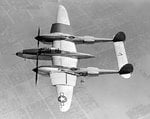In NA, perhaps the
The other "what if" questions? What if the only prototype hadn't been destroyed in a publicity stunt after only a few hours of flight testing? What if the issue of compressibility had been identified 2 years earlier and rectified before volume production? What if so much of Lockheed's production capacity wasn't tied up building British bombers and the focus had been on '38 development-getting the YPs built sooner?
Why didn't they have a second prototype in construction lagging the first by a few months? Seems very rash and risky to build only one.

